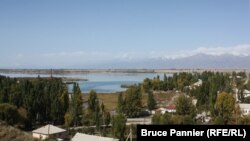
The city of Karakol lies near the eastern end of Kyrgyzstan's immense lake and premier tourist site, Issyk-Kul. Heading east across Kyrgyzstan, it is the last city (population 67,000) before the Chinese border some 150 kilometers away.
To put that into perspective, via highway, Karakol is as close to the Chinese border as the western edge of Issyk-Kul is.
Prior to my trip to cover campaigning ahead of October's parliamentary elections, I had been to Karakol two times: in late 1992 and again in 1998. The place has changed a lot and is certainly no longer the gray town I remembered from the 1990s. Karakol now is, for lack of a better word, "cooler" than it used to be.
When I arrived on the last day of September, the weather was still warm and, along with the many Kyrgyz and Russians one could see out in Karakol, there were a few dozen backpackers and bicyclists who appeared to be from Western countries. I saw some of them when I went to eat dinner at the Zarina cafe, where one could not only enjoy a good meal but watch international soccer matches on big-screen televisions mounted on the walls or take advantage of the cafe's Wi-Fi to log on to the Internet.
There are actually many attractions worth seeing in and near Karakol, but my time was short so I had to limit myself to just three.
The first was the Bugu-Enye zoo, the only zoo in all of Kyrgyzstan. I had seen months ago in Kyrgyz media that the zoo was experiencing financial difficulties and there were concerns about whether it could be kept open.
I happily paid the 70-som (about $1) entry fee and walked around. Admittedly, most of the animals in the Bugu-Enye zoo are local fauna; but many are mountain dwellers and would be difficult to spot simply hiking around. There are, of course, several Przhevalsky horses, named after the intrepid Russian explorer (we'll get to him in a minute).
Zoo director Saltanat Seitova was not in the day I visited, so her assistant Meyrambek showed me around and explained to me the zoo's financial situation. The zoo does have sponsors, the animals' cages were clean, and the animals themselves appeared to be well-fed. But Meyrambek said some of the animals could use upgraded facilities and there had been times when careful budgeting was needed to ensure all the animals were fed properly.
I know there are mixed views on keeping animals in zoos, but I have to say the Bugu-Enye zoo provided local children, who were there in large numbers the day I visited, with a great opportunity to acquaint themselves with the native animals of Kyrgyzstan and other, more exotic creatures.
The next stop was unplanned but a wonderful surprise: Karakol's central mosque. Chinese-Muslim immigrants, Dungans, constructed the mosque right after the turn of the 20th century. It is a brightly colored wooden structure with fantastically carved latticework resembling fruit and flowers adorning the buildings. And not one nail was used in building it.
The people who tend to the mosque were very friendly and glad to answer all my questions. Signs inside the complex were written in a variety of languages, including English and German.
The last stop was the Nikolai Przhevalsky Museum, which is actually located outside Karakol.
Nikolai Przhevalsky was an officer in the tsarist army and an amazing explorer, trained in cartography, botany, geology, and many other subjects. He is considered one of the greatest explorers of inner Asia in the late 19th century and is mentioned in several of the books of Peter Hopkirk, who chronicled the explorers and adventurers of the Great Game era.
Starting in 1870, Przhevalsky made four major expeditions into what was then (to Europeans) the uncharted wild of inner Asia. He traveled through Mongolia, China, and Tibet, as well as large tracts of what is now the eastern part of Central Asia. And he made Karakol his staging point for these forays into the unknown.
The Przhevalsky Museum preserves many of his instruments as well as some of his manuscripts, maps, drawings, and specimens of flora and fauna that Przhevalsky collected during his journeys.
Despite having covered many thousands of kilometers during his four expeditions, Przhevalsky never made it to his ultimate goal, which was Lhasa. On one attempt, after months of travel, he was discovered and turned away by Tibetan officials just a few days' ride from the fabled capital.
Przhevalsky is buried at the edge of the museum grounds overlooking an inlet on Issyk-Kul. The large monument built on the site faces in the direction of Lhasa.
Przhevalsky died of typhoid in 1888 as he was preparing his fifth expedition, another attempt at reaching Lhasa. Karakol was renamed Przhevalsk in his honor, and it kept that name for most of the next 100 years, until after Kyrgyzstan became independent in 1991.
Karakol is not on the beach, though it is not far from the shore, and it is a long trip to get there. The closest airport is at Tamchy on the north shore of Issyk-Kul, and it is at least a four-hour drive to reach Karakol.
But it is well worth a visit. Besides the attractions I mentioned, there are some amazing natural wonders nearby and there is a skiing area outside Karakol.
It was the edge of the civilized world when Przhevalsky lived there, but Karakol has since developed into a very interesting place.








